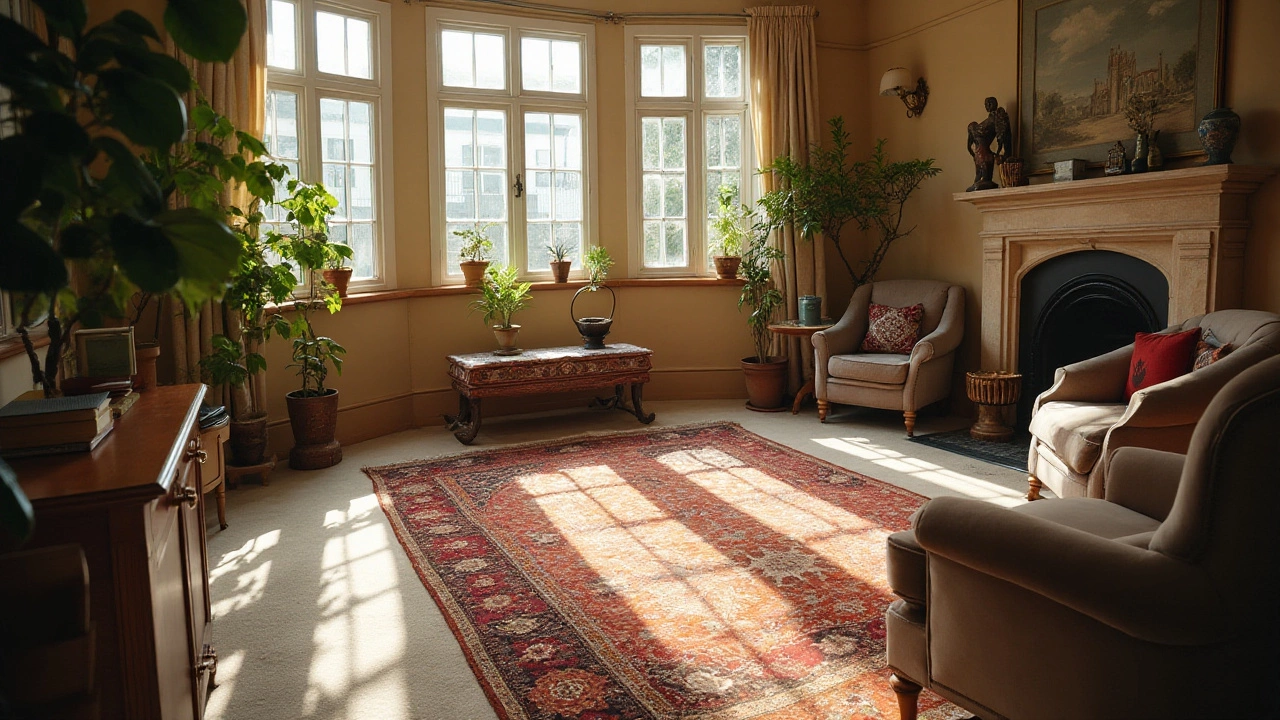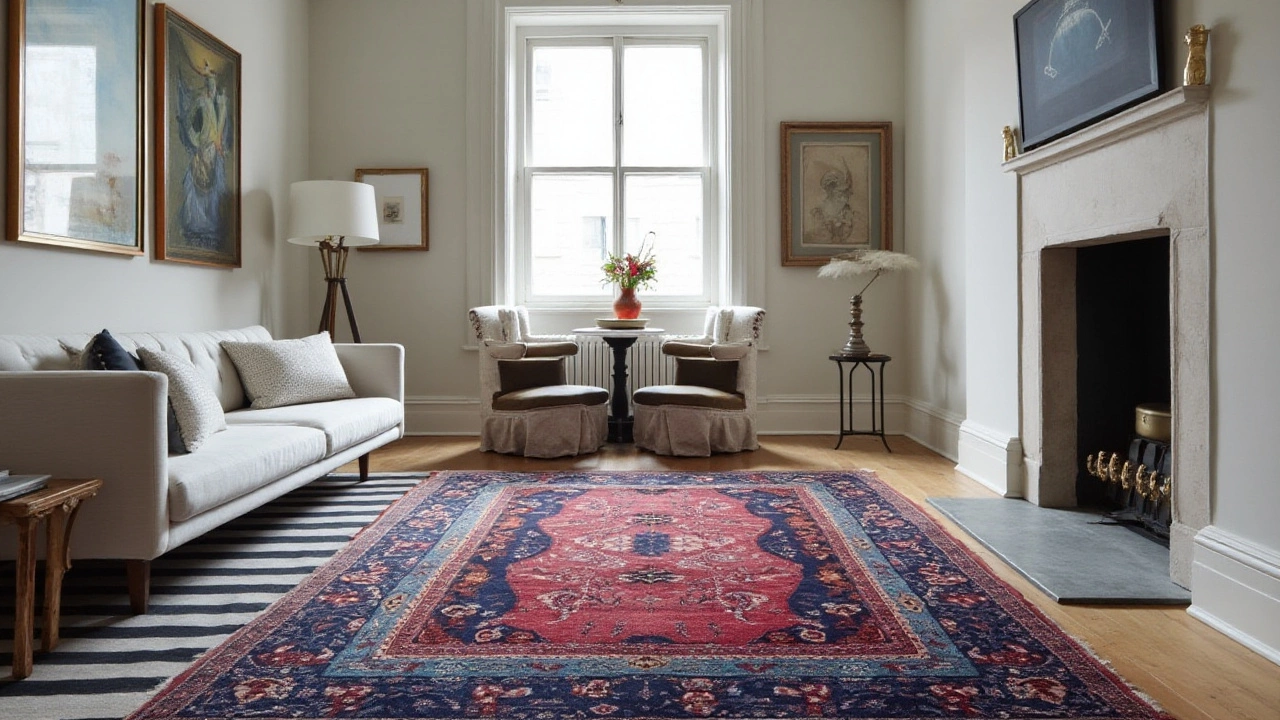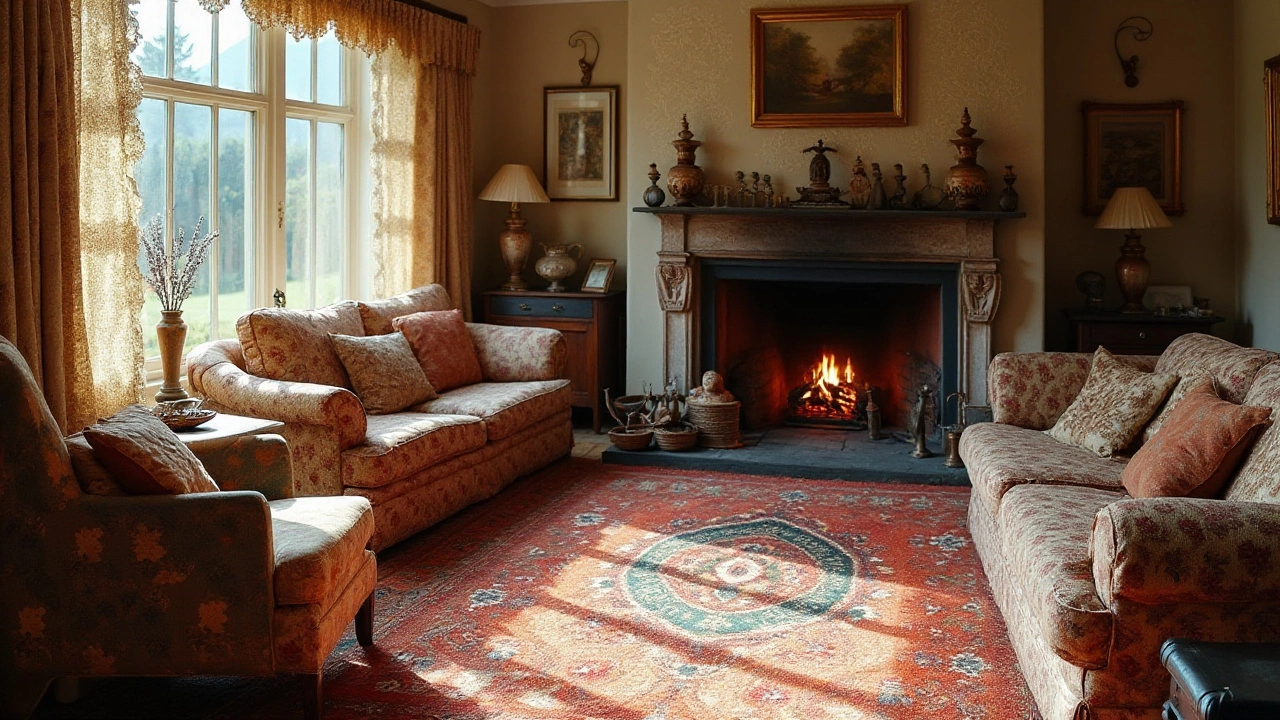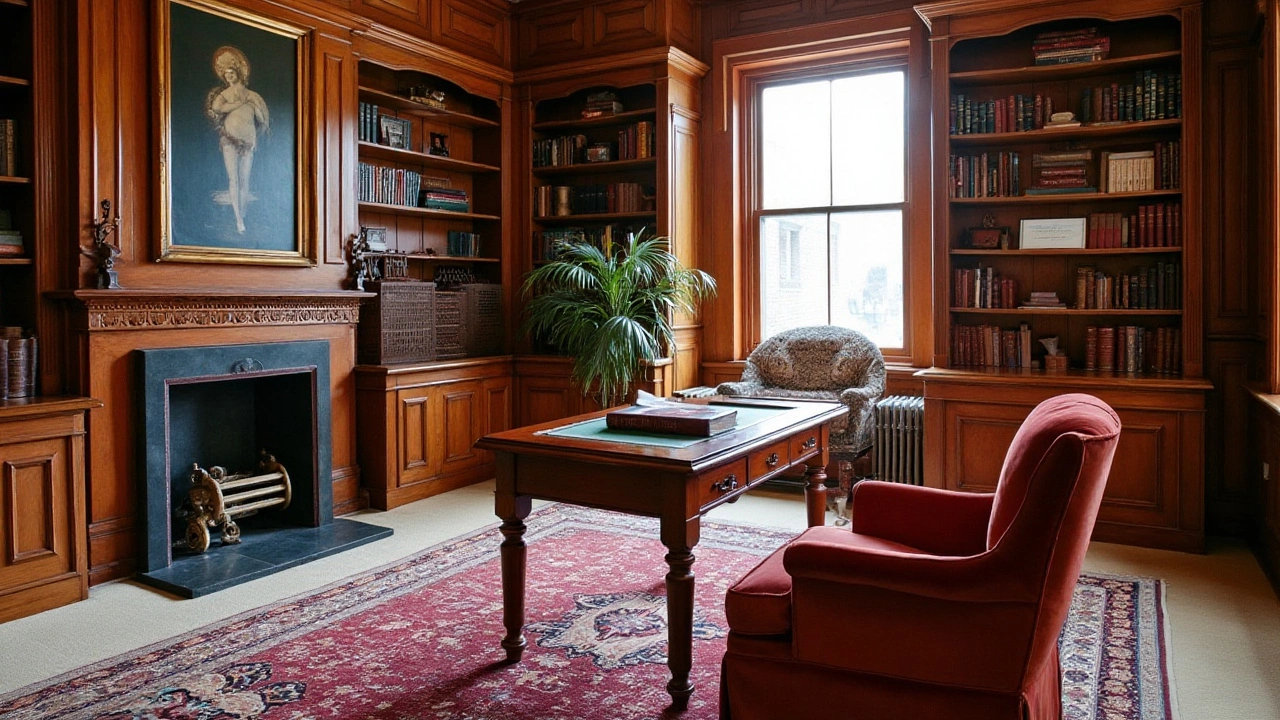Is Placing a Rug on Carpet a Smart Design Choice?
 Jan, 16 2025
Jan, 16 2025
Layering rugs on carpets isn't just a home decor trend; it's an art that can transform your living space into a cozy sanctuary. For many, the idea might seem redundant at first. Layering rugs on top of existing carpet can redefine a room’s style—adding depth, color, and warmth in ways traditional flooring often cannot.
This practical and aesthetic design choice offers homeowners and renters alike the flexibility to experiment with textures and patterns without permanent changes to existing floors. But, like any design decision, successful implementation requires a thoughtful approach to avoid common pitfalls and achieve that desired harmony in your living space.
- Why Overlap Rugs and Carpets?
- Strategic Rug Layering Tips
- Choosing the Right Rug for Your Carpet
- Potential Downsides and Their Solutions
Why Overlap Rugs and Carpets?
When it comes to interior design, creativity knows no bounds. One of the most versatile and surprisingly effective strategies is to layer a rug on carpet. But why would someone consider this seemingly redundant practice? At its core, overlapping rugs onto carpet offers a multiplicity of aesthetic and practical benefits, creating spaces that are both visually appealing and functionally sound. Unlike the usual assumption of redundancy, this clever technique allows for creative experimentation with colors, textures, and patterns which brings a sense of personal character to your home decor. From providing an additional layer of warmth to redefining spatial aesthetics, the decorative possibilities are endless.
The primary reason homeowners choose this method is to inject vibrancy and contrast into a room. Carpets, especially wall-to-wall, tend to come in neutral or monotone colors. A thoughtfully chosen rug adds an eye-catching burst of color or an intriguing detail that can either complement or contrast with the existing floor's palette. This layering helps break the monotony and introduces a new dimension to the space. The process of selecting a rug that aligns with your personal style can also infuse meaningful personality into an otherwise bland room, turning a shared living space into a unique haven tailored to one's preferences.
Another significant advantage is the added comfort and luxury. Rug layering provides an opportunity to increase softness underfoot, especially beneficial in spaces where you tend to walk barefoot. Thick rugs can enhance the tactile experience in areas like bedrooms or living rooms, making them cozy and inviting. On a functional level, they also serve to absorb sound and reduce noise levels, creating a quiet, serene environment. For those living in apartments, multiple layers can mitigate noise transmission to neighbors below.
Aesthetically, rugs can define spaces within larger rooms or open-plan homes. Overlapping rugs signal different zones, such as a reading nook or a dining area, offering a sense of order without the need for physical dividers. As larger homes increase in popularity with open concepts, interior design adopts this trend to better demarcate those spaces. By doing so, the transformative potential of rugs can be fully realized. Take for instance, a patterned rug juxtaposed atop a neutral carpet which can effectively demarcate a specific space within a larger room.
"Layering rugs on carpet isn’t just about style; it's about creating experience through texture and warmth," notes renowned interior designer, Jane Smith.
Moreover, from a budget-friendly perspective, using rugs strategically can be more cost-effective than ripping out existing carpeting. If you are less fond of your current carpet but can't justify the expense of replacement, simply enhancing it with layered rugs can refresh the look and feel without a hefty price tag. Through this smart design choice, you can also protect high traffic areas of the carpet from wear and tear, effectively elongating the life of your flooring and reducing the frequency of deep-cleaning, which saves both time and money in the long run.
Apart from aesthetics and practicality, overlapping rugs can act as creative spaces for experimentation and adaptation to seasonal influences. Rugs can be switched according to changes in season or taste preferences, lending flexibility to your design choices. This adaptability ensures that you're not locked into a particular style for long, allowing for constant evolution of your home’s ambiance in accordance with your lifestyle and needs. With such versatility, the potential of rugs becomes limitless, making a powerful statement in how effortlessly one can refresh their living environment.

Strategic Rug Layering Tips
Rug layering over carpet isn't something to jump into without a bit of planning. It’s essential to get it right, especially when you're integrating two potentially clashing textures or patterns. The first step is to consider the rug's size. Ensure that the rug is proportionate to the room and the items within it. For instance, if you have a large living area, a tiny rug might end up getting lost amidst the furniture and ample space. Conversely, a vastly oversized rug might overwhelm the room, making it appear cluttered.
Next, the texture is paramount in making this decor choice shine. If your carpet is plush, consider placing a low-pile or flat weave rug on top. This contrast helps define the layers, creating an engaging visual interest without chaos. Don't forget color coordination: complementary shades can unify the aesthetic, while a pop of color can offer a pleasing contrast. Opt for hues and patterns that either enhance or subtly contrast with what's below. It's surprising the harmony a vibrant Turkish kilim can bring atop a neutral beige carpeting.
Securing the Rug
Once you've chosen your rug, ensure it's properly secured. A significant hazard of rug layering comes from slipping, which not only ruins aesthetics but also poses a risk. Using a rug pad can prevent this. These pads can be tailored to the specific type of rug and carpet to provide the best grip. Renee McGuire, a renowned interior designer, once said,
"A rug pad not only secures your style choice but elongates the life of your beloved finds."This approach prevents both the underlying carpet and the overlaying rug from undue wear and tear.
Play with Patterns
Experimentation is key when it comes to layering rugs over carpets. Patterns can be your best friend if used skillfully. Playing with different shapes such as circular rugs on rectangular carpets or vice-versa offers a visual departure from traditionally mundane layouts. A large, neutral carpet becomes a striking canvas for an intricate and colorful patterned rug, transforming room dynamics altogether. There's a statistic from the Home Decor Institute stating that 65% of homeowners who implement pattern play in their rug choices find their spaces more engaging. This tactic frequently elicits comments of admiration from visitors, and invariably enhances the room's vibrancy.
For those concerned with making a lasting impression, especially when hosting, consider layering multiple rugs for added depth. It's an effort that underscores your dedication to design, showcasing a keen eye for the unconventional—but avoid too many clashing patterns which could lead to visual fatigue. Balance, after all, remains the linchpin of successful interior design.

Choosing the Right Rug for Your Carpet
Finding the right rug on carpet combination can turn a bland room into a vibrant masterpiece. Your choice of rug should enhance the aesthetic of your existing carpet, not clash with it. Begin by considering the texture and style of your carpet. If your carpet is plush, a flatter, finer weave rug can provide contrast without overwhelming the space. Alternatively, if your carpet is low-pile or thin, you might opt for a shaggier or plush rug to add a layer of luxury.
Color is another important factor. A monochrome or subtly patterned carpet can be brought to life with a boldly colored or patterned rug. Conversely, a busy carpet can be calmed with a neutral or solid-colored rug to create balance. Always take into account the lighting of the room as it significantly impacts how colors are perceived. Evening light can soften vibrant hues, while morning sunshine can enhance the vivacious tones in your rug, creating a different ambiance altogether.
Size matters too. A very small rug can look awkward on a large carpet area, creating a disconnected look. Ideally, the rug should be large enough to connect essential furniture pieces, like the sofa or coffee table, without dwarfing them. An appropriately sized rug defines the boundaries of your space and provides a cohesive look. Be mindful of the room's dimensions and how you want to define areas within the room when selecting rug size.
“Rugs and carpets are much more than mere floor coverings; they have become artistic statements reflecting personal style and individuality,” says Peter Brooks, an esteemed interior designer.
Choosing complementary textures and colors in rugs can elevate the look of a room significantly, providing both tactile and visual pleasure.Rugs are one of the most versatile decor elements you can add to a room; they can soften hard flooring, hide imperfections, and add warmth to any area.
Durability is another consideration. Foot traffic will affect both the rug and the carpet underneath. High-traffic areas require rugs made from materials like wool or synthetic blends that withstand wear and tear better than delicate fabrics such as silk. The rug pad is essential when layering on carpet to prevent slipping and protect both surfaces. It not only extends the life of your rug but also adds an extra layer of cushioning.
Your personal taste also plays a critical role in choosing the right rug. Do not shy away from experimenting with different styles. Consider your home’s decor theme: is it modern, traditional, or eclectic? A contemporary setting might benefit from a geometric-patterned rug, while a classic space could embrace an Oriental or Persian design, giving it a rich, timeless appeal.
Finally, the environmental impact of your rug choice could also be something to bear in mind, particularly if sustainability is important to you. Look for eco-friendly options or companies that focus on sustainable production processes if you are conscious of the green footprint of your decor. Choosing the right rug is about balancing aesthetics, practicality, and your own personality—an endeavor that requires both thought and creativity but ultimately rewards with a beautifully layered look that enriches your living environment.

Potential Downsides and Their Solutions
Layering a rug on carpet is an artful design choice, yet it's not devoid of potential pitfalls. A common concern homeowners face is rug slippage, where the rug doesn't stay firmly in place, causing both frustration and hazards. This is particularly probable with thinner rugs or those laid atop plush carpet where there's minimal friction. A straightforward solution involves using a non-slip rug pad designed for rug on carpet applications. These pads not only prevent slippage but also add extra cushioning, enhancing both safety and comfort underfoot.
Another challenge is the impact on aesthetics. If mismatched, the colors, patterns, or textures of your rug and carpet can clash rather than complement. The art here is to select rugs that harmonize with existing flooring. A neutral-toned rug can seamlessly blend into a vibrant carpet, whereas a patterned rug can add visual interest to a monotone carpet setting. The key is to focus on cohesive color palettes or contrast smartly for sophistication.
There’s also the potential issue of additional maintenance. Overlapping floor textures means catching more dirt and requiring frequent vacuuming. Rugs easily trap dust and debris that’s often missed by regular carpet maintenance. To tackle this, establish a routine cleaning schedule, perhaps emphasizing the high-traffic zones. Regular cleaning not only preserves the rug and carpet aesthetics but also extends their lifespan. Professional cleaning, though a bit pricier, can rejuvenate your flooring annually and is worth considering for an immaculate ambiance.
Quoting esteemed interior designer, Abigail Ahern, “Layering a rug on carpet creates a compelling story for your space. It’s about finding beauty in layers, even if they require patience and perseverance.”
Ahern praises the depth and character this setup imbues, emphasizing attention to detail to turn potential setbacks into extraordinary decor experiences.
Finally, a thoughtful approach to rug dimensions can mitigate the downsides associated with multiple layers underfoot. In cases of smaller rooms or narrow hallways, oversized rugs can lead to overcrowded perceptions, disrupting airflow and space perception. It’s vital to opt for appropriately sized rugs, ensuring they do not overwhelm but rather rest from furnishing edges, crafting a balance between spaciousness and coziness.